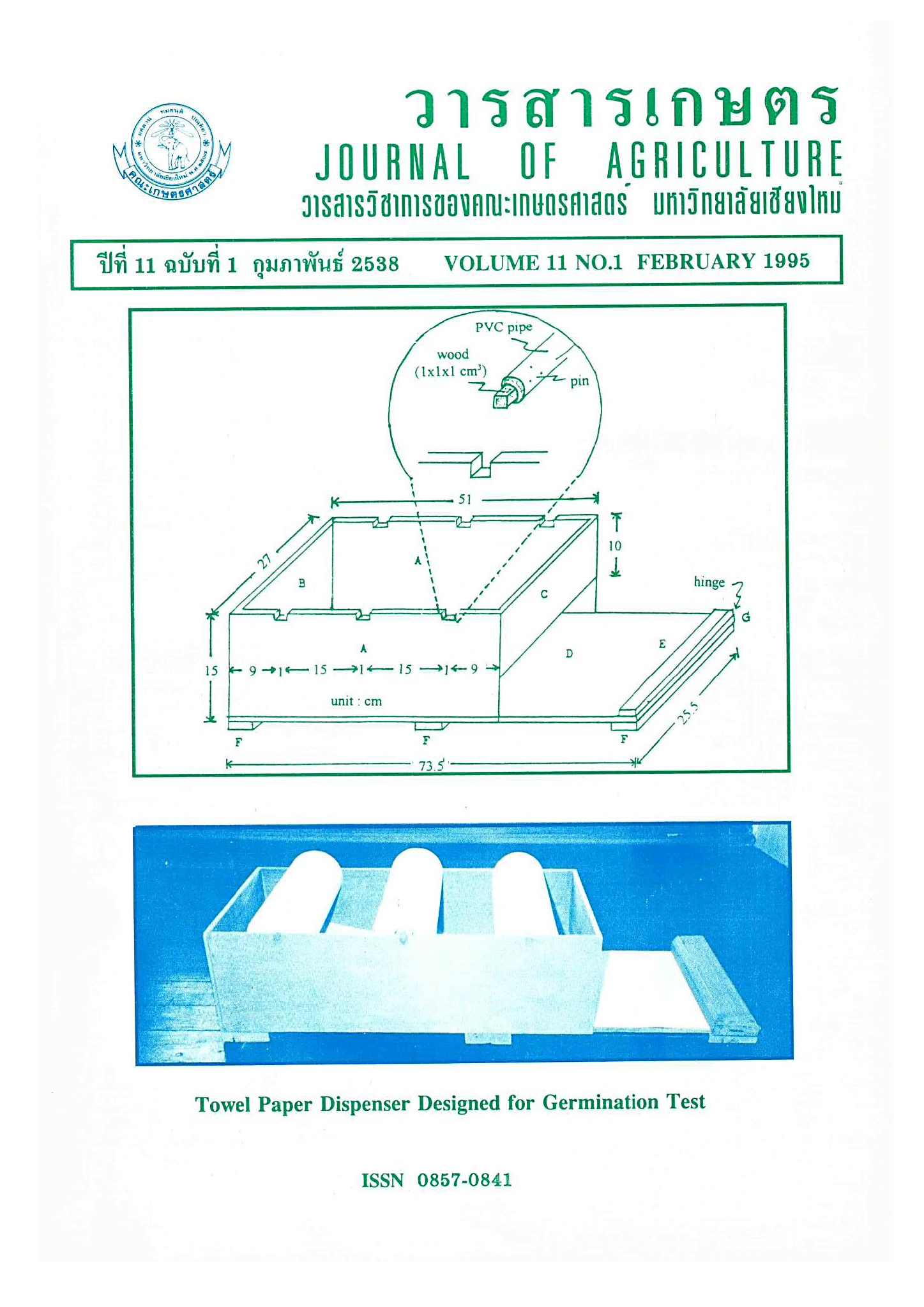การใช้กากงาทดแทนกากถั่วเหลืองในอาหารไก่เนื้อ
Main Article Content
บทคัดย่อ
งา เป็นพืชน้ำมันที่สำคัญของเขตร้อนและกึ่งร้อน ขึ้นได้ดีในดินหลายประเภท ไม่ชอบสภาพน้ำขังทนความแห้งแล้งได้ดีพอควร จึงเหมาะที่จะปลูกในหน้าแล้ง ผลผลอยได้จากการสกัดน้ำมันคือ กากงามีคุณค่าทางโภชนาการสูง กล่าวคือ กากงาชนิดผลิตเองในท้องถิ่น ซึ่งใช้วิธีการสกัดน้ำมันด้วยวิธีกล มีโปรตีน ไขมัน เยื่อใย และพลังงานใช้ประโยชน์เท่ากับ 29.6, 34.5, 10.0% DM basis และ 3.0 กิโลแคลอรี่/กรัมวัตถุแห้งตามลำดับ กากงาชนิดนี้ไม่แนะนำให้ใช้เป็นอาหารไก่เนื้อ ส่วนกากงาชนิดเมล็ดสีขาวที่ได้จากการสกัดน้ำมันด้วยสารเคมี ซึ่งนำเข้าจากประเทศจีน มีคุณค่าทางโภชนาการดีกว่ากากงาชนิดผลิตในท้องถิ่น สามารถใช้แทนที่กากถั่วเหลืองในอาหารไก่เนื้อได้ที่ระดับ 50% หรือเท่ากับใช้ในสูตรอาหารระดับ 11-16% โดยไม่ทำให้สมรรถภาพการผลิตด้อยลง
Article Details
ประเภทบทความ
บทความวิจัย
เอกสารอ้างอิง
เยาวมาลย์ ค้าเจริญ, สาโรช ค้าเจริญ, เชิดชัย รัตนเศรษฐากุล, บัญญัติ เหล่าไพบูลย์, สุวิทย์ ธีรพันธุวัฒน์, อภิชัย ศิวประภากร, พิทักษ์ ศรีประยา, สมพงษ์ ฉายพุทธ, พรรณศรี สากิยะ และบุญตา ธรรมบุตร. (2531).
การศึกษาการย่อยได้ของงาและกากเมล็ดงาในอาหารสัตว์เล็ก. ใน การใช้วัสดุในท้องถิ่นเป็นอาหารสัตว์, รายงานการประชุมสัมมนาทางวิชาการโครงการอาหารสัตว์ ไทย-เยอรมัน, หน้า 55-68, ภาควิชาสัตวบาล มหาวิทยาลัยเชียงใหม่, เชียงใหม่.
สุชน ตั้งทวีวิพัฒน์ และบุญล้อม ชีวะอิสระกุล. (2535) การใช้กากงาทดแทนกากถั่วเหลืองในอาหารสัตว์ปีก 2. ไก่ไข่. ว. เกษตร 8(3): 295-308.
สุชน ตั้งทวีวิพัฒน์ และบุญล้อม ชีวะอิสระกุล. (2536) การใช้กากงาทดแทนกากถั่วเหลืองในอาหารสัตว์ปีก 3. ชนิดเมล็ดสีขาว. ว. วิจัยและส่งเสริมวิชาการเกษตร, 10(3): 27-36.
สุชน ตั้งทวีวิพัฒน์ และบุญล้อม ชีวะอิสระกุล. (2537) การใช้กากงาทดแทนกากถั่วเหลืองในอาหารสัตว์ปีก 4. ไก่เนื้อ. ว. วิจัยและส่งเสริมวิชาการเกษตร. 11(1): กำลังพิมพ์.
Aboul, E.S.S., Samy, M.S. Sherif S.U. and Farid. F.A. (1986). Amino acids of some feed ingredients commonly used in poultry rations. Ann. Agric. Sci. (Cairo) 31(2): 1649-1662.
Al-Chalabi, K. and Taha. Z. (1972). Oilmeals from groundnut, sesame and cottonseed as the main source of plant protein in feeds for broilers in Iraq. Archiv fur Geflugelkunde 36(1): 21-24.
Baghel. R.P.S. and Netke. S.P (1987). Economic broiler ration based on vegetable proteins. Indian J. Anim. Nutr. 4(1): 24-27.
Bell, D.E., Ibrahim, A.A. Denton, G.W. Long G.G. and Bradley G.L. (1990). An evaluation of sesame seed meal as a possible substitute for soybean oil meal for feeding broilers. Poultry Sci. 69 (Suppl.1): 157.
Boekenoogen, H.A. 1968. Analysis and Characterization of Oils, Fats and Fat Products, Vol. 2. Interscience Publishers. London, UK. 681 p
Canale, A., Turi R.M. and Valente M.E. (1975). Apparent digestibility of the amino acids of sunflower and sesame oil meals by hens. Rivista di Zootecnia e Veterinaria, No 4, pp 335-343.
Ensminger, M.E. and Olentine, C.G. Jr. (1978). Feeds and Nutrition. 1st Ed. The Ensminger Publishing Company. California, USA. 824 p.
FAO. (1993). Trade Year book. FAO statistics Serics, No. 121. UN, Rome, p 220.
Heo, C.K., Lee J.Y. and Lee. Y.C. (1990). Feeding value of various plant oil meals as a substitution
of soybean meals in broiler diet. Korean J. Anim. Nutr. Feedst. 14(1): 14-19.
Hossain, M.A. and Jauncey K. (1989). Studies on the protein, energy and amino acid digestibility of fish meal, mustard oilcake, linseed and sesame meal for common carp (Cyprinus carpio L.). Aquaculture 83 (1-2): 59-72.
Kubena, L.F., Chen T.C., Deaton J.W. and Reece F.N. (1974). Factors influencing the quality of abdominal fat in broilers 3. Dietary energy levels. Poultry Sci. 53: 974-978.
Lennerts, L. (1989). Sesame cake/expeller and sesame oilmeal. Muhle + Mischfuttertechnik 126 (17): 240-241.
NRC (National Research Council). 1984. Nutrient Requirements of Poultry, 8th Ed. National Academy Press. Washington, D.C., USA. 71 p.
Yamazaki, M. and Kamata H. (1986). Amino acid availability of feed ingredients for poultry. Japanese Poultry Sci. 23(3): 147-156.
การศึกษาการย่อยได้ของงาและกากเมล็ดงาในอาหารสัตว์เล็ก. ใน การใช้วัสดุในท้องถิ่นเป็นอาหารสัตว์, รายงานการประชุมสัมมนาทางวิชาการโครงการอาหารสัตว์ ไทย-เยอรมัน, หน้า 55-68, ภาควิชาสัตวบาล มหาวิทยาลัยเชียงใหม่, เชียงใหม่.
สุชน ตั้งทวีวิพัฒน์ และบุญล้อม ชีวะอิสระกุล. (2535) การใช้กากงาทดแทนกากถั่วเหลืองในอาหารสัตว์ปีก 2. ไก่ไข่. ว. เกษตร 8(3): 295-308.
สุชน ตั้งทวีวิพัฒน์ และบุญล้อม ชีวะอิสระกุล. (2536) การใช้กากงาทดแทนกากถั่วเหลืองในอาหารสัตว์ปีก 3. ชนิดเมล็ดสีขาว. ว. วิจัยและส่งเสริมวิชาการเกษตร, 10(3): 27-36.
สุชน ตั้งทวีวิพัฒน์ และบุญล้อม ชีวะอิสระกุล. (2537) การใช้กากงาทดแทนกากถั่วเหลืองในอาหารสัตว์ปีก 4. ไก่เนื้อ. ว. วิจัยและส่งเสริมวิชาการเกษตร. 11(1): กำลังพิมพ์.
Aboul, E.S.S., Samy, M.S. Sherif S.U. and Farid. F.A. (1986). Amino acids of some feed ingredients commonly used in poultry rations. Ann. Agric. Sci. (Cairo) 31(2): 1649-1662.
Al-Chalabi, K. and Taha. Z. (1972). Oilmeals from groundnut, sesame and cottonseed as the main source of plant protein in feeds for broilers in Iraq. Archiv fur Geflugelkunde 36(1): 21-24.
Baghel. R.P.S. and Netke. S.P (1987). Economic broiler ration based on vegetable proteins. Indian J. Anim. Nutr. 4(1): 24-27.
Bell, D.E., Ibrahim, A.A. Denton, G.W. Long G.G. and Bradley G.L. (1990). An evaluation of sesame seed meal as a possible substitute for soybean oil meal for feeding broilers. Poultry Sci. 69 (Suppl.1): 157.
Boekenoogen, H.A. 1968. Analysis and Characterization of Oils, Fats and Fat Products, Vol. 2. Interscience Publishers. London, UK. 681 p
Canale, A., Turi R.M. and Valente M.E. (1975). Apparent digestibility of the amino acids of sunflower and sesame oil meals by hens. Rivista di Zootecnia e Veterinaria, No 4, pp 335-343.
Ensminger, M.E. and Olentine, C.G. Jr. (1978). Feeds and Nutrition. 1st Ed. The Ensminger Publishing Company. California, USA. 824 p.
FAO. (1993). Trade Year book. FAO statistics Serics, No. 121. UN, Rome, p 220.
Heo, C.K., Lee J.Y. and Lee. Y.C. (1990). Feeding value of various plant oil meals as a substitution
of soybean meals in broiler diet. Korean J. Anim. Nutr. Feedst. 14(1): 14-19.
Hossain, M.A. and Jauncey K. (1989). Studies on the protein, energy and amino acid digestibility of fish meal, mustard oilcake, linseed and sesame meal for common carp (Cyprinus carpio L.). Aquaculture 83 (1-2): 59-72.
Kubena, L.F., Chen T.C., Deaton J.W. and Reece F.N. (1974). Factors influencing the quality of abdominal fat in broilers 3. Dietary energy levels. Poultry Sci. 53: 974-978.
Lennerts, L. (1989). Sesame cake/expeller and sesame oilmeal. Muhle + Mischfuttertechnik 126 (17): 240-241.
NRC (National Research Council). 1984. Nutrient Requirements of Poultry, 8th Ed. National Academy Press. Washington, D.C., USA. 71 p.
Yamazaki, M. and Kamata H. (1986). Amino acid availability of feed ingredients for poultry. Japanese Poultry Sci. 23(3): 147-156.


